The flow computer market is estimated to be valued at USD 3.1 billion in 2025 and is projected to reach USD 5.3 billion by 2035, registering a compound annual growth rate (CAGR) of 5.3% over the forecast period. The flow computer market is projected to generate an incremental gain of USD 1 billion over the first five years, which represents 41.7% of the total incremental growth over the 10-year forecast period. The early-phase growth is driven by increasing adoption of flow measurement systems in oil & gas, water treatment, and industrial applications, supported by regulatory requirements for precise flow monitoring.
The gradual rise in demand for smart flow measurement technologies, such as digital and wireless solutions, contributes significantly to this early growth. The second half (2030–2035) will contribute USD 1.4 billion, representing 58.3% of the total growth, reflecting stronger momentum driven by advancements in data analytics, automation, and the increasing demand for real-time monitoring in industrial systems. Annual increments will rise from USD 0.2 billion in the early years to USD 0.4 billion by 2035, signaling a more rapid expansion. Manufacturers focusing on improving accuracy, reducing operational costs, and integrating flow computers with IoT-based systems will capture the largest share of this USD 2.4 billion opportunity.
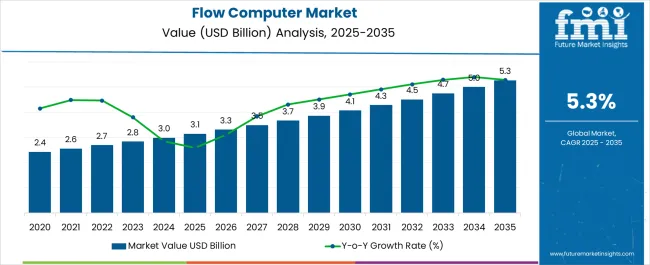
| Metric | Value |
|---|---|
| Flow Computer Market Estimated Value in (2025 E) | USD 3.1 billion |
| Flow Computer Market Forecast Value in (2035 F) | USD 5.3 billion |
| Forecast CAGR (2025 to 2035) | 5.3% |
The current landscape reflects growing investments in process automation and real-time data acquisition technologies, particularly in industries where operational efficiency and compliance with safety standards are critical.
The future outlook remains positive as more facilities adopt advanced flow computing systems that enable accurate measurement, enhanced diagnostics, and remote control functions. The shift toward digital infrastructure and smart field instrumentation is further accelerating adoption.
Developments in low-power electronics, improved communication protocols, and software-based integration are expected to shape the evolution of flow computers, offering scalable and future-ready solutions. With global emphasis on cost optimization, reduced downtime, and regulatory compliance, flow computers are positioned to serve as integral components in next-generation industrial control systems.
The flow computer market is segmented by type, application, technology, end use, and geographic regions. By type, the flow computer market is divided into Field Flow Computers, Portable Flow Computers, Stationary Flow Computers, and Integrated Flow Computers. In terms of application, the flow computer market is classified into Oil and Gas, Water and Wastewater, Chemical Industry, Food and Beverage, and Pharmaceuticals.
Based on technology, the flow computer market is segmented into Ultrasonic Flow Meters, Electromagnetic Flow Meters, Magnetic Flow Meters, and Mechanical Flow Meters. By end use, the flow computer market is segmented into Industrial, Commercial, and Residential. Regionally, the flow computer industry is classified into North America, Latin America, Western Europe, Eastern Europe, Balkan & Baltic Countries, Russia & Belarus, Central Asia, East Asia, South Asia & Pacific, and the Middle East & Africa.
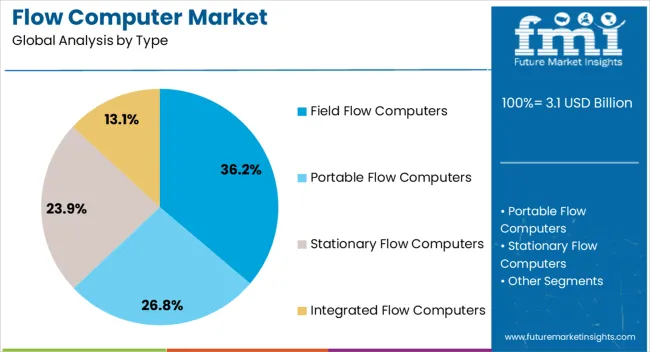
Field Flow Computers are projected to account for 36.2% of the total Flow Computer market revenue in 2025, emerging as the leading segment by type. This segment’s growth has been supported by the increasing preference for on-site processing of flow data, enabling real-time control and operational decision-making without dependence on centralized systems.
The ability of field flow computers to operate in remote and harsh environmental conditions has made them ideal for deployment in oilfields, refineries, and pipelines. Their compact form factor, combined with high reliability and interoperability with multiple sensor types, has allowed seamless integration across legacy and new systems.
Moreover, the push toward decentralized data processing and the demand for low-latency operations have reinforced the importance of field-deployed flow measurement solutions. As industries move toward more autonomous operations, field flow computers are expected to remain critical due to their role in ensuring continuous, accurate, and locally managed data capture.
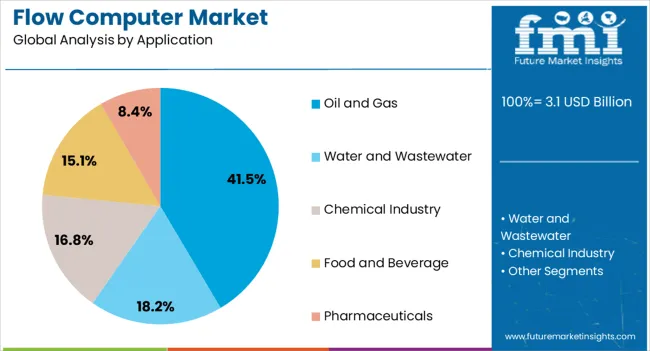
The Oil and Gas application segment is estimated to represent 41.5% of the Flow Computer market revenue in 2025, maintaining its dominance across end-use industries. This leadership position is being driven by the critical need for accurate flow measurement in upstream, midstream, and downstream operations, where even minor discrepancies can result in substantial financial losses.
Flow computers have become essential in custody transfer, wellhead monitoring, and pipeline flow analysis, enabling precise tracking of hydrocarbons under varying pressure and temperature conditions. As digital transformation accelerates across the oil and gas value chain, the demand for intelligent measurement systems with remote diagnostics and regulatory reporting capabilities has grown significantly.
Furthermore, operational safety and environmental monitoring requirements have strengthened the reliance on high-accuracy computing platforms With the sector's continued focus on asset optimization and performance analytics, flow computers are expected to play an increasingly central role in managing complex and distributed fluid systems.
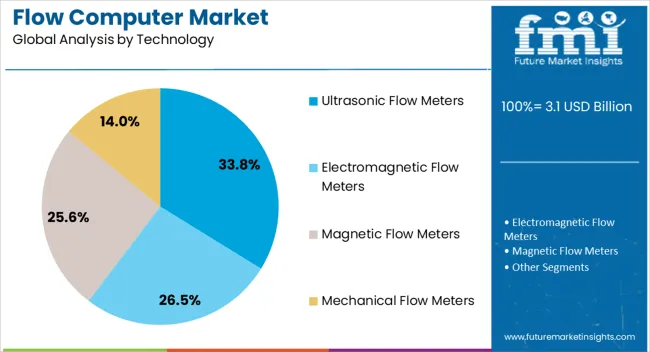
Ultrasonic Flow Meters are expected to contribute 33.8% of the Flow Computer market revenue in 2025, positioning this technology as a key enabler of precise and non-intrusive flow measurement. Growth in this segment is being fueled by increasing demand for maintenance-free and highly accurate solutions that can operate without disrupting the flow of liquids or gases.
The ability of ultrasonic technology to function across a broad range of temperatures and fluid types has made it highly suitable for both liquid and gas measurement applications. Adoption has been particularly strong in sectors where clean measurement environments and low pressure drop are required.
Additionally, the integration of ultrasonic meters with advanced flow computers enhances diagnostic capabilities, providing operators with critical insights into system performance. As industries pursue higher operational efficiency and reduced lifecycle costs, ultrasonic flow meters are expected to maintain strong momentum due to their long-term reliability, minimal installation footprint, and high data accuracy.
The flow computer market is driven by the growing demand for real-time monitoring and control, particularly in the oil & gas and utilities sectors. Opportunities in expanding industrial operations and trends toward IoT integration are shaping the market. However, high initial costs and installation complexities remain barriers to adoption. By 2025, overcoming these challenges through cost-effective and efficient solutions will be essential for continued market growth.
The flow computer market is growing due to the increasing demand for real-time monitoring and control in industrial operations. Flow computers are used to accurately measure and control the flow of liquids and gases in industries like oil and gas, water treatment, and chemicals. These systems improve operational efficiency and safety by providing real-time data analysis. By 2025, the market will continue expanding as industries prioritize automation and precise monitoring to enhance productivity and reduce downtime.
Opportunities in the flow computer market are growing with the expansion of the oil & gas and utilities sectors. In oil and gas, accurate flow measurement and control are essential for efficient extraction, transportation, and distribution of resources. Similarly, the increasing demand for water and energy management in utilities is driving the need for reliable flow control systems. By 2025, the market will see significant growth as both sectors continue to invest in advanced monitoring solutions for efficient resource management.
Emerging trends in the flow computer market include the integration of flow computers with IoT and data analytics systems. The use of IoT allows for real-time data collection, remote monitoring, and predictive analytics, enhancing the accuracy and efficiency of flow measurements. By 2025, the combination of IoT connectivity and advanced data analytics will drive the adoption of smarter, more integrated flow control systems, offering businesses more insights into their operations and enabling better decision-making.
Despite growth, challenges such as high initial costs and complex installations persist in the flow computer market. The cost of advanced flow computers can be prohibitive, especially for small and medium-sized businesses. Additionally, integrating these systems into existing infrastructures can be technically challenging and time-consuming. By 2025, addressing these challenges through cost-effective solutions and simplified installation processes will be critical for expanding the market and increasing adoption across industries.
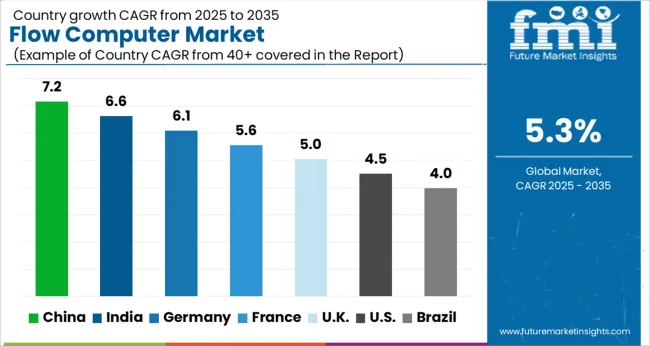
The global flow computer market is projected to grow at a 5.3% CAGR from 2025 to 2035. China leads with a growth rate of 7.2%, followed by India at 6.6%, and France at 5.6%. The United Kingdom records a growth rate of 5%, while the United States shows the slowest growth at 4.5%. These varying growth rates are driven by factors such as the increasing demand for accurate and reliable flow measurement systems, the growing industrialization, and the need for efficient resource management. Emerging markets like China and India are experiencing higher growth due to rapid industrial development, infrastructure expansion, and investments in energy and oil & gas sectors, while more mature markets like the USA and the UK see steady growth driven by advancements in automation, smart technologies, and regulatory compliance in industries such as oil & gas, water treatment, and power generation. This report includes insights on 40+ countries; the top markets are shown here for reference.
The flow computer market in China is growing rapidly, with a projected CAGR of 7.2%. China’s expanding industrial base, coupled with the increasing demand for precise flow measurement systems in industries such as oil & gas, energy, and water treatment, is driving the market’s growth. The country’s heavy investments in infrastructure development and energy sectors, along with its push toward greater energy efficiency and environmental sustainability, are contributing significantly to the demand for advanced flow computers. Additionally, the growing adoption of smart technologies and automation in industrial processes further accelerates market adoption.
The flow computer market in India is projected to grow at a CAGR of 6.6%. India’s increasing demand for accurate and efficient flow measurement systems in its rapidly growing oil & gas, water treatment, and power generation industries is driving market expansion. The country’s emphasis on modernizing its infrastructure, improving resource management, and adopting automation technologies is further contributing to market growth. Additionally, India’s growing focus on sustainability and regulatory compliance in industries that require precise flow measurement systems is accelerating the demand for flow computers.

The flow computer market in France is projected to grow at a CAGR of 5.6%. France’s steady demand for flow measurement systems in its industrial sectors, particularly in oil & gas, energy, and water treatment, is driving market growth. The country’s emphasis on energy efficiency and environmental sustainability, combined with increasing investments in smart infrastructure and industrial automation, is contributing to the market’s steady expansion. Additionally, France’s regulatory framework for energy management and environmental protection continues to promote the adoption of accurate and reliable flow computer technologies.
The flow computer market in the United Kingdom is projected to grow at a CAGR of 5%. The UK’s demand for reliable and efficient flow measurement systems in sectors like oil & gas, utilities, and industrial processes is contributing to steady market growth. The country’s focus on digitalization, automation, and sustainable practices in industrial operations is driving the adoption of flow computers. Additionally, the UK government’s commitment to energy efficiency, carbon emissions reduction, and smart grid technologies further accelerates the demand for advanced flow measurement solutions.
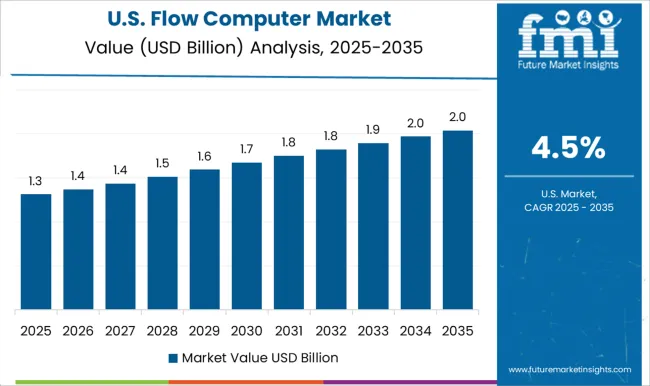
The flow computer market in the United States is expected to grow at a CAGR of 4.5%. The USA market remains steady, driven by the growing demand for precise flow measurement systems in the oil & gas, water treatment, and power generation sectors. The country’s increasing focus on industrial automation, energy efficiency, and regulatory compliance is contributing to market growth. Additionally, the USA is investing in smart grid infrastructure and the integration of advanced technologies in industrial applications, which is driving the adoption of flow computers.
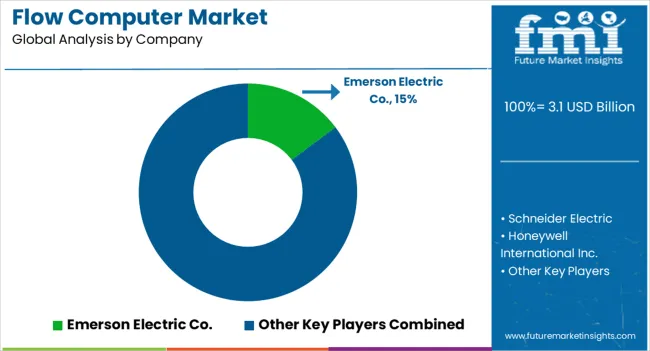
The flow computer market is dominated by Emerson Electric Co., which leads with its advanced flow computing solutions designed for industries such as oil and gas, chemical, and water treatment. Emerson’s dominance is supported by its cutting-edge technology, extensive product portfolio, and strong customer relationships.
Key players such as Schneider Electric, Honeywell International Inc., and Yokogawa Electric Corporation maintain significant market shares by offering reliable and scalable flow computer systems that provide accurate measurement and control of fluid flow, enabling better process efficiency and regulatory compliance. These companies focus on integrating advanced software, real-time data analytics, and cloud solutions to optimize performance in critical industrial applications. Emerging players like Sensus (A Xylem Brand), Endress+Hauser, and OMNI Flow Computers, Inc. are expanding their market presence by offering specialized flow computers tailored for niche applications such as water management, renewable energy, and environmental monitoring. Their strategies include enhancing data processing capabilities, offering customizable solutions for diverse industries, and improving ease of integration with existing systems. Market growth is driven by increasing demand for real-time data collection, the need for regulatory compliance in fluid measurement, and the rise in smart metering and automation technologies. Innovations in IoT connectivity, machine learning algorithms, and predictive analytics are expected to continue shaping competitive dynamics and fuel further growth in the global flow computer market.
| Item | Value |
|---|---|
| Quantitative Units | USD 3.1 Billion |
| Type | Field Flow Computers, Portable Flow Computers, Stationary Flow Computers, and Integrated Flow Computers |
| Application | Oil and Gas, Water and Wastewater, Chemical Industry, Food and Beverage, and Pharmaceuticals |
| Technology | Ultrasonic Flow Meters, Electromagnetic Flow Meters, Magnetic Flow Meters, and Mechanical Flow Meters |
| End Use | Industrial, Commercial, and Residential |
| Regions Covered | North America, Europe, Asia-Pacific, Latin America, Middle East & Africa |
| Country Covered | United States, Canada, Germany, France, United Kingdom, China, Japan, India, Brazil, South Africa |
| Key Companies Profiled | Emerson Electric Co., Schneider Electric, Honeywell International Inc., Yokogawa Electric Corporation, Sensus (A Xylem Brand), Endress+Hauser, Siemens AG, KROHNE Group, OMNI Flow Computers, Inc., Kessler-Ellis Products, Cameron International, ABB, Rockwell Automation, Thermo Fischer Scientific, and Dynamic Flow Computers |
| Additional Attributes | Dollar sales by computer type and application, demand dynamics across oil and gas, water treatment, and industrial sectors, regional trends in flow computer adoption, innovation in real-time monitoring and data analysis technologies, impact of regulatory standards on measurement accuracy and safety, and emerging use cases in smart grids and predictive maintenance. |
The global flow computer market is estimated to be valued at USD 3.1 billion in 2025.
The market size for the flow computer market is projected to reach USD 5.3 billion by 2035.
The flow computer market is expected to grow at a 5.3% CAGR between 2025 and 2035.
The key product types in flow computer market are field flow computers, portable flow computers, stationary flow computers and integrated flow computers.
In terms of application, oil and gas segment to command 41.5% share in the flow computer market in 2025.






Full Research Suite comprises of:
Market outlook & trends analysis
Interviews & case studies
Strategic recommendations
Vendor profiles & capabilities analysis
5-year forecasts
8 regions and 60+ country-level data splits
Market segment data splits
12 months of continuous data updates
DELIVERED AS:
PDF EXCEL ONLINE
Flow Pack Films Market Size and Share Forecast Outlook 2025 to 2035
Flow Pack Machine Market Size and Share Forecast Outlook 2025 to 2035
Flow Indicator Market Size and Share Forecast Outlook 2025 to 2035
Flow Chemistry Market Size and Share Forecast Outlook 2025 to 2035
Flow Wrappers Market Size and Share Forecast Outlook 2025 to 2035
Flow Meter Devices Market Size, Share, and Forecast 2025 to 2035
Flow Cytometry Market - Trends & Growth Forecast 2025 to 2035
Flow Wrap Packaging Market Growth from 2025 to 2035
Flow Wrap Machines Market by Horizontal & Vertical Systems Through 2025 to 2035
Flower Extract Market Analysis by Type, Application and Form Through 2035
Flow Meters Market Growth - Trends & Forecast 2025 to 2035
Flow Wrap Machines Market Analysis – Size, Share & Industry Trends 2025-2035
Flower Box Market Demand & Floral Packaging Innovations 2024 to 2034
Flow Diverter Market Analysis – Size, Trends & Forecast 2024-2034
Flow Wrap Market from 2024 to 2034
Flowback Tank Market Growth – Trends & Forecast 2024-2034
Flowpack Paper Packaging Market
Flow Cytometer Market
Inflow Pressure Screen Market Analysis - Size, Share, and Forecast Outlook 2025 to 2035
Inflow Control Devices Market Analysis - Size, Growth, and Forecast 2025 to 2035

Thank you!
You will receive an email from our Business Development Manager. Please be sure to check your SPAM/JUNK folder too.
Chat With
MaRIA